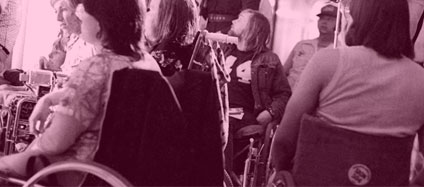Introduction to the Five Steps to Tactical Innovation
Sun Tzu’s The Art of War tells us that planning without action is futile and action without planning is fatal.
Assignment 1: Read Douglas A. Johnson’s The Need for New Tactics,which discusses how activists can make their work more effective.
Lesson 2: “Know Yourself” – Defining Your Problem and Vision
Practice identifying problems and goals from case examples of human rights struggles.
Choose a key issue to work on as you practice the steps involved in tactical innovation.
Assignment 1: Read “Self Care: Caring for your Most Valuable Resource” from the New Tactics Book.
Assignment 2: Develop a self-care plan of your own.
Lesson 3: “Know Your Terrain” – Introducing and Using the Tactical Map Tool
Learn how to use a tactical map tool to visualize the people, groups, institutions, and the nature of relationships involved in a chosen problem.
Identify targets for action on a problem using a tactical map.
Assignment 1: Read the Tactical Mapping Instructions and create a Tactical Map using your own problem and goal example.
Lesson 4: “Know the Terrain, Know Yourself and Know Your Opponent” – Introducing and Using the Spectrum of Allies Tool
Learn how to identify and arrange stakeholders involved in an issue along a continuum of active opponents to active allies using a Spectrum of Allies.
Choose tactics, based on the theory of shifting actors toward the support side of the spectrum.
Assignment 1: Using the tactical map that you created for your problem, create your own Spectrum of Allies.
Lesson 5: Explore and Select Tactics
Learn how others have used the Spectrum of Allies to develop tactics designed to increase support for their goal and to decrease the power of the those opposing them.
Observe the process of creating a tactic from the examples provided, using a Spectrum of Allies analysis.
Assignment 1: Read “How to Explore and Select Tactics” and “Adapting Tactics” from the New Tactics Book.
Assignment 2: Use the Spectrum of Allies and Tactical Map analysis to identify a target and several tactics for your problem and goal.
Lesson 6: Step Five – Creating an Action Plan, Applying Strategy and Tactics
Practice the process of adapting a tactic from a different problem to your problem and context.
Outline the elements of a tactical Plan of Action, the final step of the five steps to tactical innovation.
Observe how to set specific milestones in a Plan of Action that can be celebrated in order to keep momentum during a long campaign.
Assignment 1: Complete the Strategy and Tactics Summary Form.
___
Attribution List “The Center for Victims of Torture – New Tactics in Human Rights Project” as the source for any information used in this document as well as any original attribution provided in this document.
Noncommercial The information is not to be used for profit.
Share Alike If you alter, transform, or build upon this work, you may distribute the resulting work only under the same, similar or a compatible license. And share your alterations, etc with CVT-New Tactics to continue to build the body of knowledge.
Five Steps to Tactical Innovation for Human Rights: Lesson 1
Lesson 1: Introduction to Strategy and Tactics
Five Steps to Tactical Innovation – Lesson 1 from Tavaana
Learner Objectives
1. Identify the foundations for strategic and tactical thinking.
Strategy without tactics is the slowest route to victory. Tactics without strategy is the noise before defeat. — Sun Tzu, The Art of War
In Lesson 1 you will be introduced to each other and to the reasoning behind the Five Steps to Tactical Innovation taught in this course. The steps draw conceptually from the writings of Sun Tzu in The Art of War, written more than 2,000 years ago. It tells us that planning without action is futile and action without planning is fatal.
Sun Tzu said that good strategy is based on three sources of knowledge:
Knowing yourself (goals, resources, strengths and limits, allies)
Knowing your opponent (goals, resources, strategy, strengths and weaknesses, allies)
Knowing the terrain (social, political, cultural relationships, institutions and structures – where the “battle” will be fought).
Douglas Johnson, the Executive Director for the Center for Victims of Torture, gives six reasons why innovative tactics and a means to develop them are needed to succeed in achieving your goals.
2. Define key terms used in the course.
These are some of the important terms we use throughout the course. These words are used to mean many different things in different contexts. The definitions given here are the way we use them for our purposes.
3. Name the five steps to connect strategy and tactics.
1. Identify the problem
2. Build a common vision
3. Define the terrain (Using Tactical Map and Spectrum of Allies tools)
Identify relationships around the identified social problem
Identify allies and opponents on a continuum
4. Explore and select tactics
5. Develop a plan of action for implementation
Now follow the online syllabus starting with the first reading: The Need for New Tactics by Douglas A. Johnson.
Lesson 1 Syllabus
Essential resource materials for this course:
New Tactics in Human Rights: A Resource for Practitioners
Readings
1. Introduction to Lesson 1
2. New Tactics Methodology
3. Key Terms (refer to this again, as needed)
4. Need for New Tactics (Johnson) and
5. Introduction to New Tactics Notebook (Goldstone)
Webinar
Date and time: Wed. Feb. 2, 2011, 8pm Tehran time
Nancy Pearson: “How will tools for strategic and tactical thinking help you better achieve your goals?”
___
Attribution List “The Center for Victims of Torture – New Tactics in Human Rights Project” as the source for any information used in this document as well as any original attribution provided in this document.
Noncommercial The information is not to be used for profit.
Share Alike If you alter, transform, or build upon this work, you may distribute the resulting work only under the same, similar or a compatible license. And share your alterations, etc with CVT-New Tactics to continue to build the body of knowledge.







